Ptudes lab: odometry, SLAM and visualization experiments
Project description
This is a playground of various experiments with SLAM, mapping and visualization of lidar point clouds. (Ptudes name is an interplay of P(oint) (e)Tudes, derived from Etude)
It’s heavily using and relying on Ouster sensor lidar data, Ouster SDK, public datasets that contain Ouster lidar data and lidar odometry poses obtained from KISS-ICP package.
Everything in ptudes-lab package works for multi Python (3.8 - 3.11) and multi OS (Linux, MacOS, Windows).
Table of contents:
Flyby 3d visualizations of lidar data with poses
Review the registered point cloud map using the per scan poses of the odometry/slam pipeline with deskewing and point coloring by REFLECTIVITY, NEAR_IR, SIGNAL and RANGE channels (channels availability depends on the UDP Lidar Profile of the data).
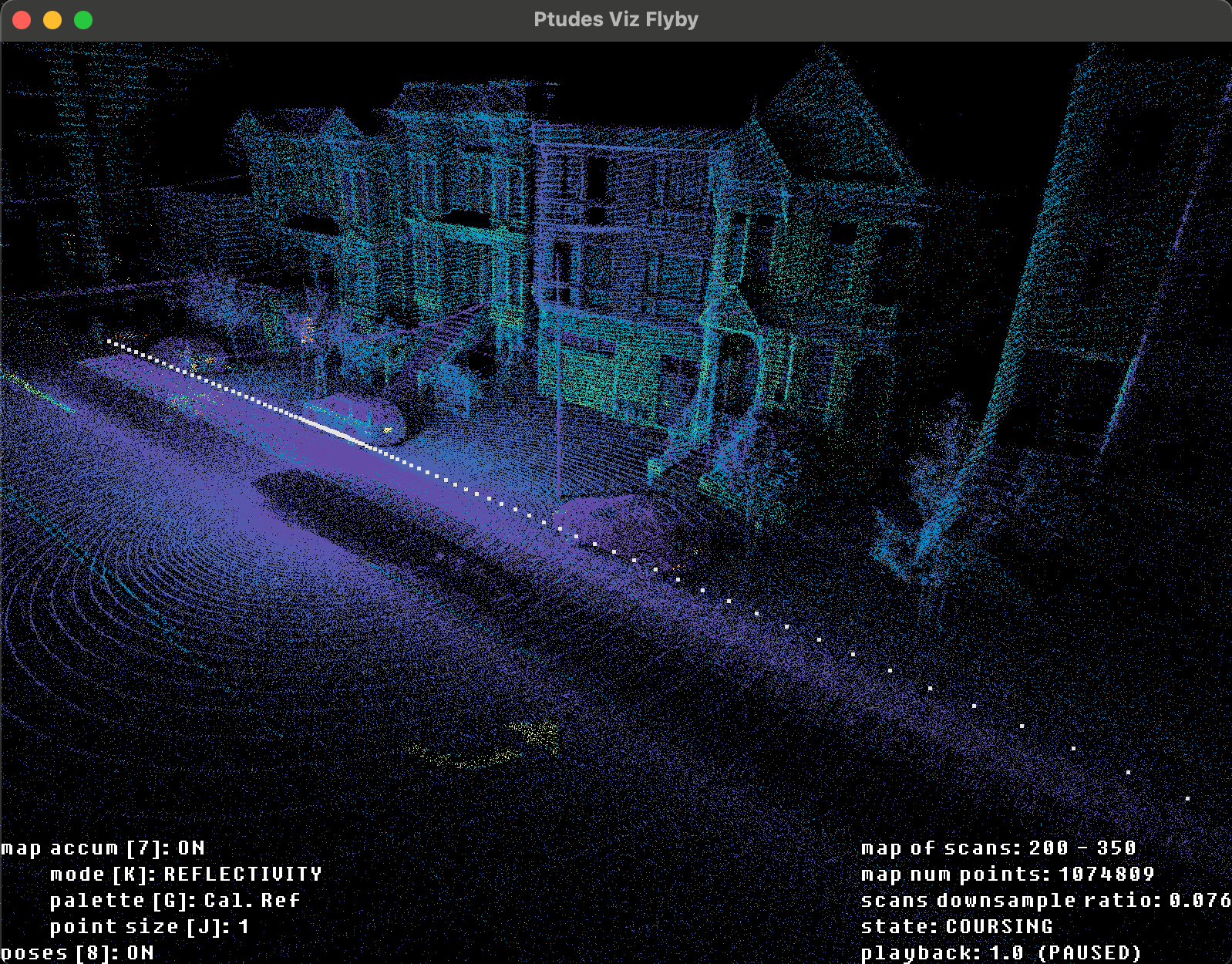
Pre-requisite:
0. Installation
You can install ptudes-lab using Pip from the PyPi using:
pip install ptudes-lab
or you can install it in editable mode if you plan to modify the code (or want to use not yet released features):
git clone https://github.com/bexcite/ptudes-lab.git cd ptudes-lab pip install -e .
NOTE: Don’t forget to use venv or any other means of controlling the Python environments, they always save a lot of time later down the road.
1. Get Ouster sensor lidar data in a .pcap/.bag format
You can download a sample data from the official sensor docs:
Or you can record it from the sensor if you have one, using ouster-sdk/cli:
ouster-cli source <MY_SENSOR_IP> record
2. Get the lidar scans poses in kitti format or NC GT format
You KISS-ICP pose outputs in KITTI format directly running the official kiss_icp_pipeline on the previously obtained Ouster .pcap data using:
kiss_icp_pipeline --deskew ./OS-0-128_v3.0.1_1024x10.pcap
You can use any pose source with --kitti-poses in the command ptudes flyby below and not necessarily KISS-ICP output. For example it can be the result of some post-processing step (smoothing, loop closure, fusion with other sensors etc) the only requirement is that the number of poses should be the same as the number of scans in the .pcap/.bag file.
Alternatively you can run ptudes ekf-bench ouster command with --save-nc-gt-poses poses.csv to get the trajectory in Newer College Dataset Ground Truth format (NC GT), which has a much better utility value since it contains timestamp per pose and can be used to calculate ATE between trajectories.
How to run:
Once you have Ouster sensor .pcap/.bag data and poses per every scan in KITTI format (or NC GT format) you can run ptudes flyby command as:
ptudes flyby ./OS-0-128_v3.0.1_1024x10.pcap --kitti-poses ./OS-0-128_v3.0.1_poses_kitti.txt
or for example using .bag from Newer College dataset and the NC GT ground truth data:
ptudes flyby ./newer-college/2021-ouster-os0-128-alphasense/collection1/2021-07-01-10-37-38-quad-easy.bag \
--meta ./newer-college/2021-ouster-os0-128-alphasense/beam_intrinsics_os0-128.json \
--nc-gt-poses ./newer-college/2021-ouster-os0-128-alphasense/collection1/ground_truth/gt-nc-quad-easy.csv \
--start-scan 20 \
--end-scan 50
Use --help to see more options like --start-scan/--end-scan to view only a specific range of scans.
Some useful keyboard shortcuts for flyby command:
Key |
Action |
|---|---|
SPACE |
Stop/Start flying |
> |
Increase/decrease flying speed |
8 |
Toggle poses/trajectory view |
k / K |
Cycle point cloud coloring mode of accumulated clouds or map |
g / G |
Cycle point cloud color palette of accumulated clouds or map |
j / J |
Increase/decrease point size of accumulated clouds or map |
ROS bags visualizations of raw lidar data
Ouster sensors produce raw lidar_packets/imu_packets data in corresponding ROS topics. To view the point cloud from such raw packets BAGs without spinning a ROS and installing all drivers one can use ptudes viz command.
Not tested with ROS2 bags:(
I wasn’t been able to locate the ROS2 bag with raw Ouster lidar_packets, so if you by any chance have such a ROS2 bag that you can share with me I can make sure that both ROS1 and ROS2 bags working for the ptudes viz command. (i.e. ptudes.bag.OusterRawBagSource packet source can work with ROS1/ROS2 bags)
For example to visualize Newer College dataset BAGS use:
ptudes viz ./newer-college/2021-ouster-os0-128-alphasense/collection1/2021-07-01-10-37-38-quad-easy.bag \
--meta ./newer-college/2021-ouster-os0-128-alphasense/beam_intrinsics_os0-128.json
and it will open:
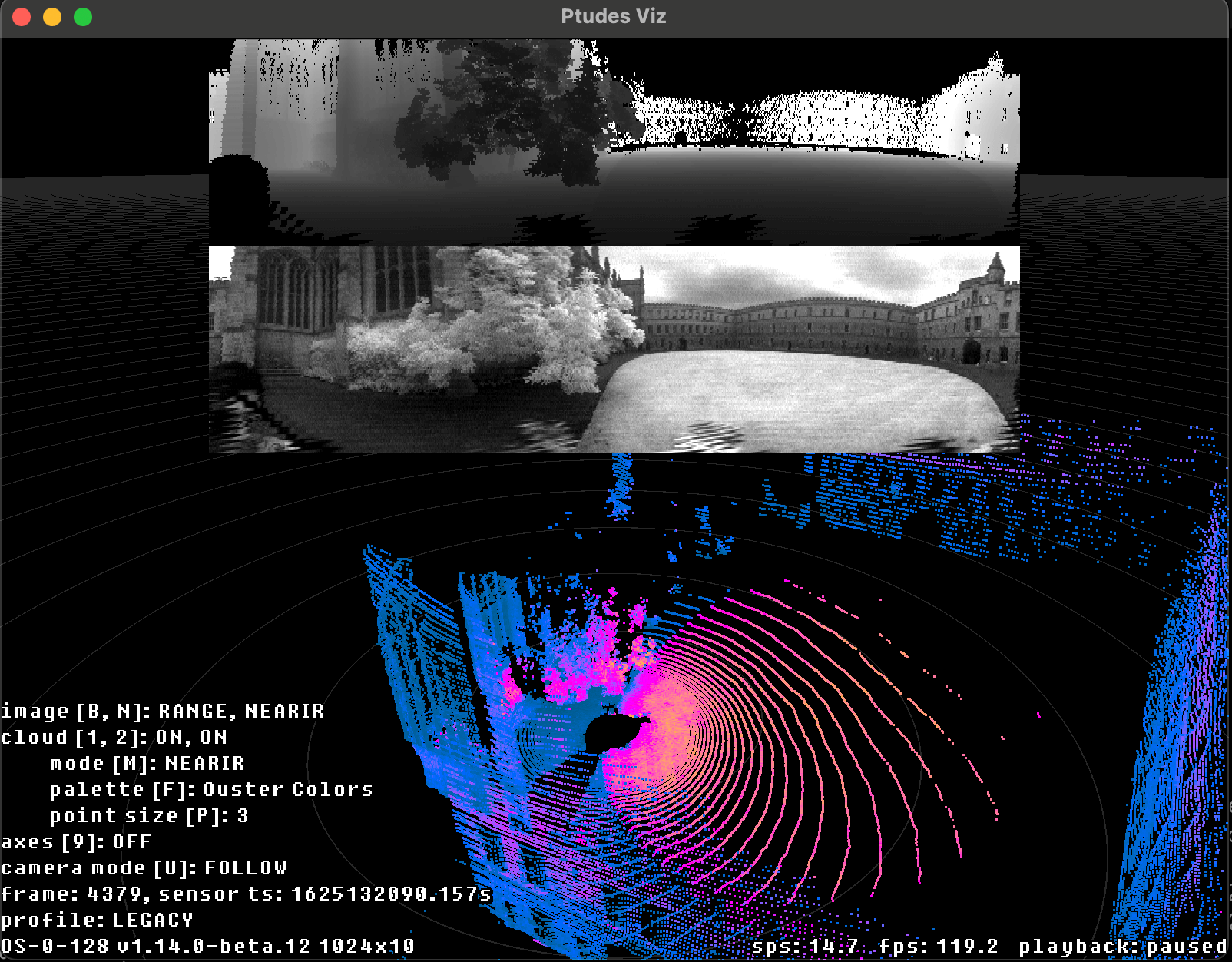
Since the underlying Viz is the PointViz shipped with Ouster SDK the full list of keyboard shortcuts can be found here
Ouster Lidar/IMUs + KissICP + trajectory smoothing (Error-State EKF)
NOTE: Refer to the blog post Lidar odometry smoothing using ES EKF and KissICP for Ouster sensors with IMUs for ES EKF formulation details and experiments described in details.
Ouster Lidar raw .pcap/.bag recordings almost always come with imu_packets inside which may be used to get better trajectories estimation on some tricky cases, like tunnels with less features, fast platform movements or lower resolution sensors. (though it’s not universally better and need to be used with caution).
ptudes ekf-bench CLI has various tools with ES EKF implementation that uses the Ouster imu_packets together with KissICP.
ES EKF as a smoothing filter for KissICP trajectories
Use ptudes ekf-bench ouster command that can run on Ouster Lidar raw recordings in .pcap/.bag and outputs smoothed KissICP poses that can be compared with available ground truth automatically (in Newer College Dataset format) by plotting trajectories together and calculating Average Trajectory Error (ATE).
For example, result of the run on quad-easy.bag from the collection1 of NCD looks like this:
ptudes ekf-bench ouster ./newer-college/2021-ouster-os0-128-alphasense/collection1/2021-07-01-10-37-38-quad-easy.bag \ --gt-file ./newer-college/2021-ouster-os0-128-alphasense/collection1/ground_truth/gt-nc-quad-easy.csv \ --save-nc-gt-poses quad-easy.csv \ -p graphs
With graphs showing the smoothing in action:
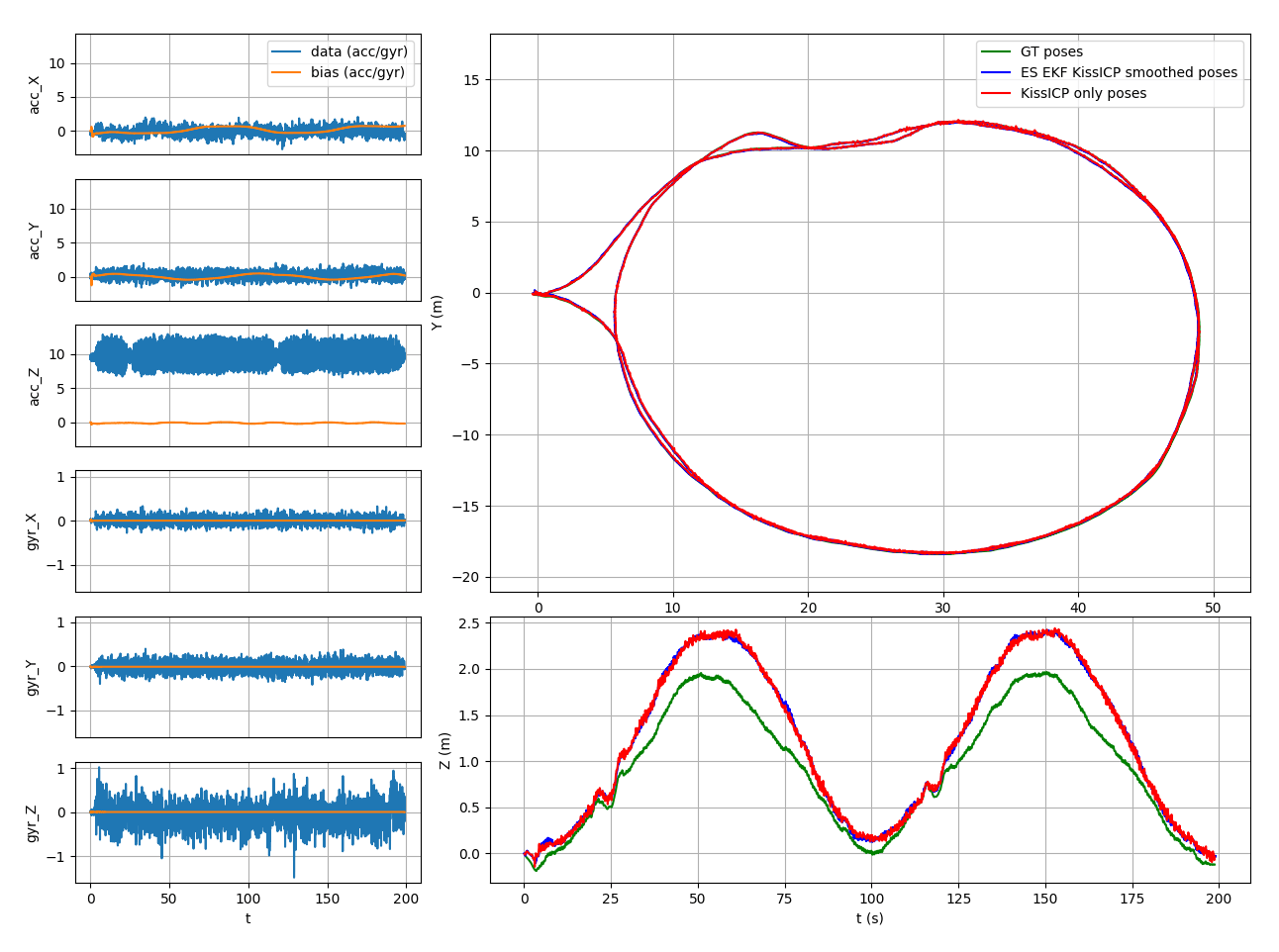
and KissICP adaptive threshold estimates per scan with a corresponding pose innovation from ICP update:
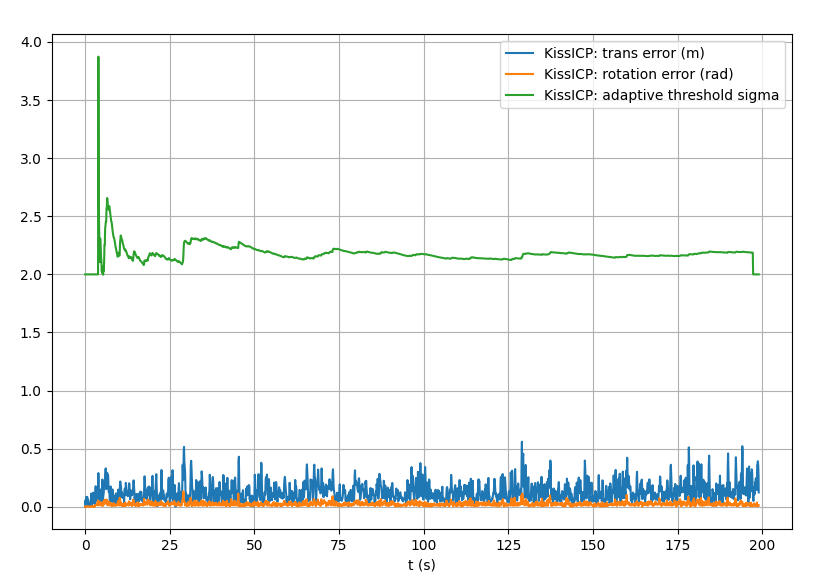
To use ES EKF prediction as a KissICP initial guess, you can use --use-imu-prediction option with ptudes ekf-bench ouster.
And then use ptudes ekf-bench cmp command to compare various trajectories:
ptudes ekf-bench cmp ./newer-college/2021-ouster-os0-128-alphasense/collection1/ground_truth/gt-nc-quad-easy.csv \ quad-easy.csv \ quad-easy-imu-pred.csv \ -p graphs --xy-plot
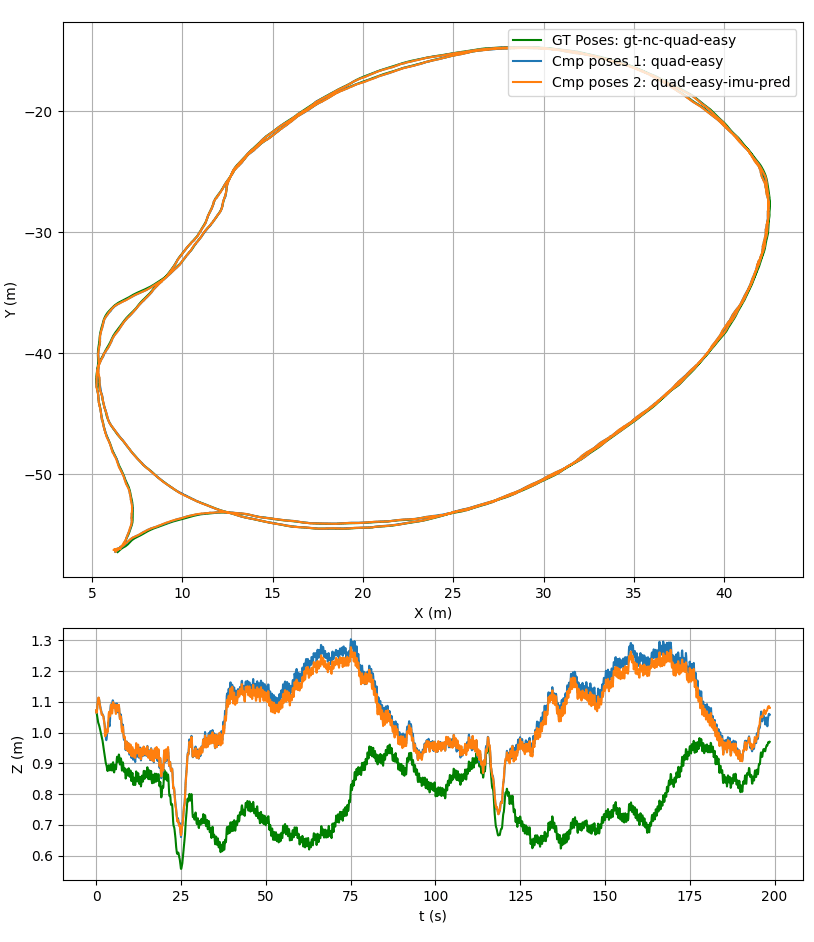
Project details
Release history Release notifications | RSS feed
Download files
Download the file for your platform. If you're not sure which to choose, learn more about installing packages.
Source Distribution
Built Distribution
Hashes for ptudes_lab-0.0.3-py3-none-any.whl
| Algorithm | Hash digest | |
|---|---|---|
| SHA256 | e14846c60a256fbb32ed7f8f45d982ee824bd3f7e220c4d9062906a9bbda7520 |
|
| MD5 | 4a97c162201a91bd64ef88376de2ece9 |
|
| BLAKE2b-256 | b3c50d26914ec92c6096badfe69bd53e33f013f448dc19eafd08252548fadd31 |











